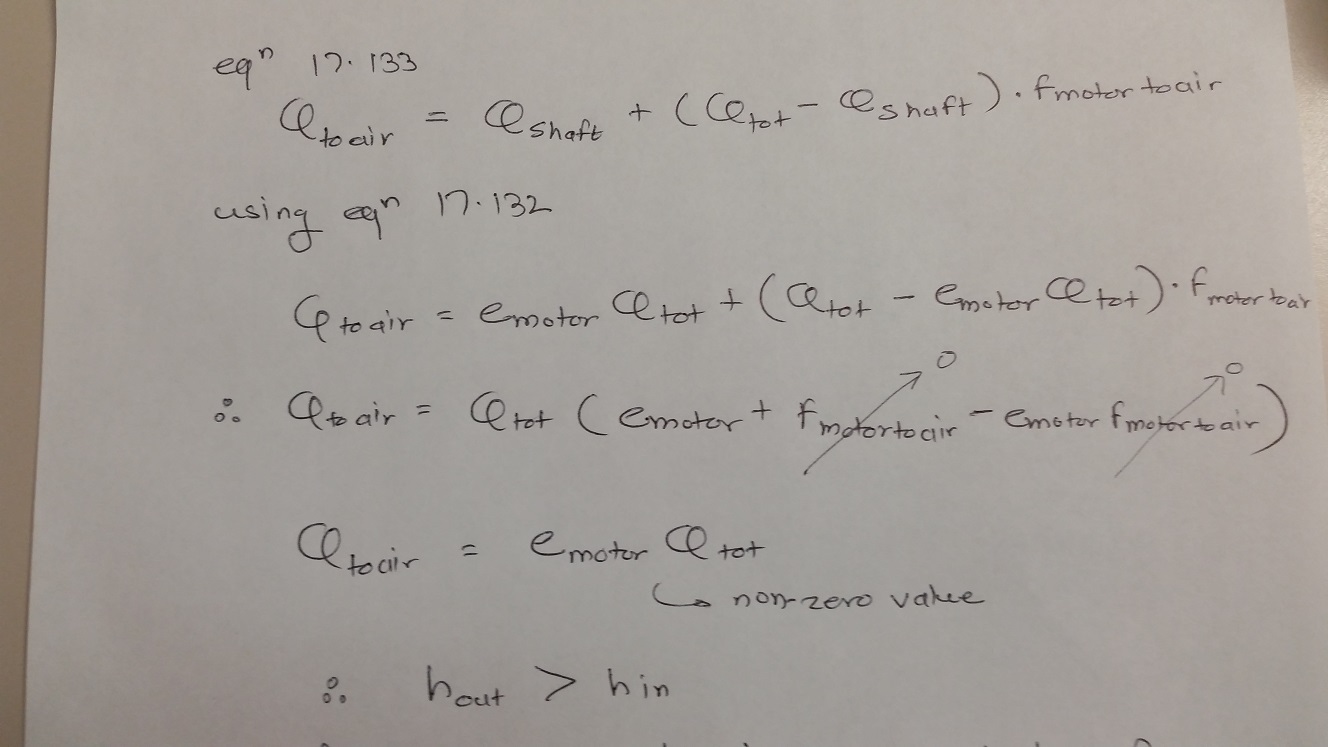First time here? Check out the Help page!
 | 1 | initial version |
This is interesting. As Adam mentioned, I checked the equations in 17.4 Air System Fans. From the equations (17.131 to 17.136), even if f_motortoair is 0, it does not imply the Q_toAir variable is 0, therefore, the enthalpy of air at the outlet is not equal to enthalpy at the inlet. (check the derived equations in image)
h_out > h_in
The psychrometric function (eq. 17.136) calculates fan outlet drybulb temperature higher than the inlet fan air temperature. Therefore even if f_motortoair = 0, there is addition of heat and T_out > T_in
 | 2 | No.2 Revision |
This is interesting. As Adam mentioned, I checked the equations in 17.4 Air System Fans. From the equations (17.131 to 17.136), even if f_motortoair is 0, it does not imply the Q_toAir variable is 0, therefore, the enthalpy of air at the outlet is not equal to enthalpy at the inlet. (check the derived equations in image)
h_out > h_in
The psychrometric function (eq. 17.136) calculates fan outlet drybulb temperature higher than the inlet fan air temperature. Therefore even if f_motortoair = 0, there is addition of heat and T_out > T_in
 | 3 | No.3 Revision |
This is interesting. As Adam mentioned, I checked the equations in 17.4 Air System Fans. From the equations (17.131 to 17.136), even if f_motortoair is 0, it does not imply the Q_toAir variable is 0, therefore, the enthalpy of air at the outlet is not equal to enthalpy at the inlet. (check the derived equations in image)
h_out > h_in
The psychrometric function (eq. 17.136) calculates fan outlet drybulb temperature higher than the inlet fan air temperature. Therefore even if f_motortoair = 0, there is addition of heat and T_out > T_in
 | 4 | No.4 Revision |
This is interesting. As Adam mentioned, I checked the equations in 17.4 Air System Fans. From the equations (17.131 to 17.136), even if f_motortoair is 0, it does not imply the Q_toAir variable is 0, therefore, the enthalpy of air at the outlet is not equal to enthalpy at the inlet. (check the derived equations in image)
h_out > h_in
The psychrometric function (eq. 17.136) calculates fan outlet drybulb temperature higher than the inlet fan air temperature. Therefore even if f_motortoair = 0, there is addition of heat and T_out > T_inT_in.
 | 5 | No.5 Revision |
This is interesting. As Adam mentioned, I checked the equations in 17.4 Air System Fans. From the equations (17.131 to 17.136), even if f_motortoair is 0, it does not imply the Q_toAir variable is 0, therefore, the enthalpy of air at the outlet is not equal to enthalpy at the inlet. (check the derived equations in image)
h_out > h_in
The psychrometric function (eq. 17.136) calculates fan outlet drybulb temperature higher than the inlet fan air temperature. Therefore even if f_motortoair = 0, there is addition of heat and T_out > T_in.

